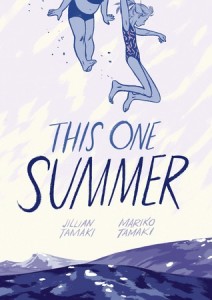Graphic novel This One Summer by Jillian Tamaki and Mariko Tamaki has been the source of a lot of attention since its release in 2014. A coming of age comic centered around Rose, an ordinary teenage girl, whose summer trip with her family to the beach is strange and and different from the years previous, not because of anything external, but because the age at which she is and the feelings she’s processing. This tale earned prestige with landmark wins of both Printz and Caldecott Honor Awards for its beautiful art and moving story, but also earned the target of censors who railed against the work for everything from the inclusion of LGBTQ+ characters to its illustrations.
The announcement of the 2014 Caldecott Medal winner and honorees had many people rushing to pick up the books for their library and classroom collections. This One Summer broke boundaries by becoming the first graphic novel to make the short list for the Caldecott Medal. Unfortunately, the Caldecott honor yielded an unforeseen negative outcome: Since the announcement of the Caldecott honor, CBLDF has been confidentially involved in monitoring challenges to This One Summer in various communities.
The American Library Association describes the Caldecott Medal as an award that “shall be awarded annually to the artist of the most distinguished American picture book for children published by an American publisher in the United States in English during the preceding year.” The Medal has been awarded to illustrators since 1938, and while it is only given to one book, the Caldecott committee also recognizes the “runners-up” as Caldecott Honor Books.
The Caldecott Medal and Honor are given to illustrators whose work is suitable for children up to 14 years of age. An examination of past Caldecott winners and honorees reveals that most of the recipients created books for the younger end of the age range. In the last ten years alone, about 82% of Caldecott winners have been aimed at audiences age 8 and younger. As a result, many people have the expectation that Caldecott winners and honorees are meant for the youngest readers.
Comics are breaking new ground with the recognition of This One Summer by the Caldecott committee. This One Summer is absolutely eligible and deserving of the Caldecott honor, but problems arise when people order the book based on its award pedigree rather than familiarity with the subject matter and intended audience. A few people, believing the book is aimed at younger readers because it is a Caldecott Honor Book, have been shocked to find that the award winning graphic novel is intended for audiences age 12 and up. Instead of acknowledging their responsibility for knowing the content of a book before purchasing it, some of these people have instead attacked the book, calling for its removal.
This One Summer was named the most challenged book of 2016 in the American Library Association’s annual Top Ten Challenged Books list, with complaints citing its inclusion of LGBTQ+ characters, drug use, and profanity, and it was considered sexually explicit with mature themes. In 2016, the book was removed from a K-12 library in Henning, Minnesota. CBLDF found out about the removal after the fact, and we led a coalition in defending the book, which was restored, albeit with the unsatisfactory decision that it could only be accessed by students in grades 10-12 and only if they have parental permission.
- Henning School Board Restores This One Summer to Library, with Restrictions
- CBLDF Joins Defense of This One Summer in MN School
- This One Summer Banned in Minnesota School
This One Summer was also subject to a heavily biased media attack in Seminole County, Florida. It was initially removed from county elementary schools, but the district took the censorship one step further and reviewed the book in area high schools without a formal challenge. CBLDF led the defense of the book once again, ensuring the book was retained in the high schools without restriction.
- VICTORY in Florida: This One Summer Unrestricted in Seminole County High Schools
- CBLDF Leads Fight for This One Summer in Seminole County High Schools
- This One Summer Now Challenged in Seminole County High Schools
- This One Summer Removed from Seminole County Elementary Schools
This One Summer made the ALA’s Most Challenged and Banned list again a couple years later. With the arguments against the comics’ profanity, illustrations, and sexual references, the graphic novel ended up as the 7th most frequently challenged and banned out of the 347 challenges tracked in 2018 to materials in libraries, schools, and universities by the ALA OIF. 483 books were reported in total to ALA as challenged or banned in 2018.
Additional resources:
Using Graphic Novels in Education: This One Summer
Adding This One Summer to Your Library or Classroom Collection
